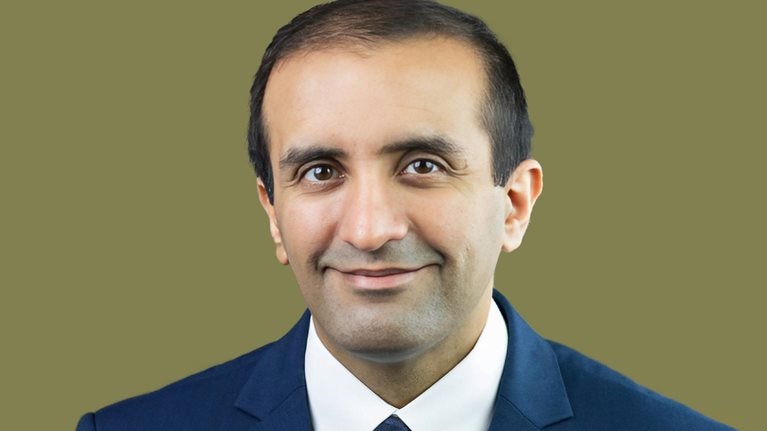The COVID-19 pandemic exposed underlying inequities in healthcare and also forged new partnerships among governments, hospitals, and community-based organizations—partnerships that can serve as models for improving health equity in non-pandemic times.
“Investing in communities, I have found, is an antidote to the plague of mistrust in public health,” says Raj Panjabi, MD, former special assistant to US President Biden and senior director for global health security and biodefense at the White House National Security Council (NSC).
Panjabi, who served in his role with the NSC from February 2022 to August 2023, has also taught at Harvard Medical School and cofounded Last Mile Health, an organization that partners with governments to train and empower community health workers to provide essential primary healthcare to the world’s most remote communities.
McKinsey Health Institute global leader Pooja Kumar sat down with Panjabi as his tenure with the Biden administration was winding down. As a follow-up to part one of the interview on pandemic prevention and preparedness, below Panjabi discusses more about his personal background, his work as a social entrepreneur, and his thoughts on health equity, access, and healthcare worker capacity.
The interview has been edited for clarity and length.
Pooja Kumar: Raj, you and I first met as undergraduates heading to medical school. You’ve had a really varied career looking at health. Tell us a bit about your journey to where you are today.
Raj Panjabi: I came to America as a refugee with my family when I was nine years old, around 1990, fleeing the war in Liberia. My family lost a whole lot, but here in the US we had a chance to rebuild our lives and benefit from a community that rallied around us.
My father had this saying growing up: “No condition is permanent.” We’re not defined by the circumstances we face but by how we respond. My parents were extraordinary entrepreneurs; they hustled and started a clothing shop, and that helped put me through college and medical school.
While I was in medical school, I went back to Liberia to see if I could be part of serving the people we’d left behind. I found utter destruction. Fifty doctors to serve a country of four million people. If you got sick in a city where those few doctors remained, you might stand a chance. But if you were living in rural areas where there was already a shortage of doctors, made even worse by the war, you were out of luck.
The idea that illness is universal and healthcare is not became quite real to me as a clinician. Seeing people die from conditions they really shouldn’t die from in the 21st century: complications of childbirth, malnutrition, HIV. That set me on a journey to pursue medicine as a path and also to become a social entrepreneur.
I worked with other Liberians and American health workers to launch Last Mile Health, which is focused on trying to close that gap in healthcare by hiring, training, and equipping local community members as community health workers to really expand the medical team and bring care out of hospitals and clinics to the people themselves. I had the privilege of leading that organization as CEO for about 15 years.
‘We’ve got to bring care to people’
Pooja Kumar: You’ve sat in the role of a public sector leader. You’ve also sat in the role of the social sector leader in your prior role at Last Mile Health. How do you see that relationship working five, ten years from now to address pandemics and other health issues, like the healthcare worker dearth across the world?
Raj Panjabi: What I’ve seen in my years as CEO of Last Mile Health and as a social entrepreneur is that increasingly, the most intractable social problems require some ability to shape public policy, to get financing or have a public subsidy to, for instance, make a healthcare model work for the poor, or in rural areas, or for the economically marginalized in urban areas.
At Last Mile Health, working with governments around the world to get things like HIV or malaria further under control, we found that we’ve got to bring care to people, not wait for people to come to care.
If you’re a child, and you have a fever in the middle of a rain forest, and you’re in a malaria endemic place like Liberia where I grew up, and you have to wait days for your mother to take you down to the canoe, paddle across, and walk through the forest to get to a clinic to get to a doctor to get tested and treated, you may lose your life. In fact, many do.
If you can hire a local community health worker in that forest community to bring that test and treatment to you, assess if you have a complicated case, connect you to an outreach nurse and bring you to the hospital—that’s the vision of healthcare. What we found in the social sector is that the very places where that model is the most powerful—rural areas—is where so much of healthcare is publicly financed. And we have had to work with many governments to figure out how to shift their policies to better pay those workers, better equip them, better train them.
The majority of community health workers are women. And if you look at the way women are compensated in the healthcare sector, we can see that the gaps are wide. According to a recent Women in Global Health report, six million women go unpaid or underpaid every single year in healthcare.
So the ability to see a problem in the social sector and demonstrate solutions that could work—for instance, putting community health workers under contract and paying them—then working with the public sector to transform policy, that’s just logical—whether it’s between this country and others, or within this country, between federal, state, local, tribal, and territorial health departments.
Healthcare worker capacity
Pooja Kumar: I think one of the real problems of our generation is healthcare worker capacity. It feels like there are many areas in the US and throughout the world where it’s becoming more and more urgent, as folks are burned out from COVID-19, finding other opportunities to be able to feed their families, and so on. If you had a magic wand, what would be the top two or three things you would do to really increase healthcare worker capacity?
Raj Panjabi: First of all, I would work within the private sector, public sector, and social sector to make a commitment to have gender equity in pay. Abolishing the idea that women should get paid less, or that caregiving roles—whether staffed by women or men—should get paid less. We have to shift from a principles and values perspective. And that needs to come from the CEOs of hospitals; it needs to come from the presidents of countries; it needs to come from governors of states.
The second thing is to then shift policy to enable that, and to hardwire into every part of the healthcare and public health system a focus not just on products but on people.
One way we’ve done that in the Biden–Harris administration, through the American Rescue Plan Act of 2021, was to put $3.2 billion of investment into America’s public health workforce at the local and state level: 107 jurisdictions, in every state in this country, have $3 billion over the next five years to put toward data scientists, epidemiologists, and veterinarians who work to stop the bird flu outbreak, and community health workers.
The third thing we’ve got to do is to build the public’s understanding and the political constituency to keep that going. I think we all understand how critical our doctors, nurses, lab scientists, and community health workers are when a pandemic happens. You saw murals celebrating doctors, nurses, community health workers, and others; you heard people bang pots and pans when hospitals were overwhelmed with COVID-19 patients.
We need a constituency of people who push their leaders at the local level to keep investing in these health workers in between major pandemics, not just when we have a pandemic.
There’s a clear, commonsense case to make for it. There’s also a very strong economic case to make for it. For every dollar you invest in health workers—closing that shortage that we have here and around the world—you get $9 of return. In the case of community health workers, for every dollar in, you get $10 back, one analysis just showed.1 And that’s by averting and mitigating outbreaks, by extending healthier life years, and through job creation. This shouldn’t be seen as a cost; when it’s done the right way, it’s an investment. There’s always more to do to make sure the health sector is contributing to the job creation we need over the long term.
The role of technology
Pooja Kumar: What about the role of technology? There’s been a lot of talk about it, and how we can extend the reach of healthcare through technology. How do you see that playing out?
Raj Panjabi: Ever since the advent of medicines and diagnostic tests, technology’s been at the core of medicine. I saw how powerful this was in my first job in health, about 22 years ago, on the Yukon River Delta in Alaska, where the state had worked for about 50 years to try to extend the reach of healthcare to rural communities across the state.
In 2001, they were training local community health workers and nurses in every Alaskan Native community—fishing villages on the Delta, for instance—on how to become part of a telemedicine system. At the time, that meant, for example, using digital cameras to take pictures of rashes so they could send them to dermatologists in regional hospitals for help with a diagnosis; or sending video otoscopies of a child’s eardrums to ear, nose, and throat specialists to help diagnose and address recurrent infections of otitis media. Technology was used to train these community health aides to triage when an adult presented with chest pain. You’ve got to be able to tell: Is it because of their heart? Or maybe they’re anxious? Or maybe they’ve got a little heartburn? You can’t do that anywhere in the world unless you have an EKG. Part of my job was to work with these community health aides to teach them to use a very simple red, yellow, and green color-coded, 12-lead EKG and then transmit the EKG tracings to a cardiologist or a general physician to diagnose.
I bring up that example because the reason the Alaskans were [training community health workers] was, first and foremost, to improve quality of care, to save more lives, and to reduce suffering. But they found it also provided a way to improve equity, to bring the kind of care that wasn’t available in those rural communities, and to be more efficient economically.
That idea of extending healthcare that’s high tech, high touch, and community based with technology, you see it play out in many different ways, including during the COVID-19 emergency phase of the pandemic when stay-at-home orders were in effect in many places. It became harder to train physicians and nurses on the front lines in new protocols at the same time you had a novel pandemic and had to learn new things.
As with my Massachusetts hospital at the time, some of us volunteering on the front lines learned online what to do when we went into the COVID-19 testing clinics in April 2020. In Ethiopia, groups like Last Mile Health helped the Ethiopian government train their 40,000 health extension workers and their doctors and nurses on Ethiopia’s clinical protocols for COVID-19 by leveraging smartphones and creating apps that allowed the government to see whether or not a doctor or nurse actually understood the protocol for administering oxygen, or providing treatment, by transmitting their quiz scores from the app centrally, in real time, and then adapting and sending out more training as we learned about therapies that worked.
Think about any future pandemic—we’re going to have to develop, in most cases, novel therapies, or at least test existing ones. And we’ll need that kind of capability again. We’ll also need it between pandemics. The need for addressing quality, equity, and efficiency is going to need more of that merger between high-tech and high-touch care.
Investing in healthcare workers
Pooja Kumar: Hearing you talk, it’s just so evident that we have many examples to draw on, whether they are local to the US, or global, and that there’s no shortage of ways people have tried to tackle this problem of not having enough healthcare workers. Some of our research suggests there’s going to be between a 20 and 30 percent shortage of nurses in the US alone.
How do we move from an experimentation mindset to a scaled mindset? Any lessons learned, from your vantage points in public sector or social sector, that would say, “This is how we need to do it to start making a bigger commitment to change”?
Raj Panjabi: One of the key things is to see the opportunity for harnessing, leveraging, and engaging the parts of the workforce that may be considered the lowest paid, the least compensated, the most peripheral, the least appreciated, and actually recognize their contribution, support their contribution, and engage them in clinical care and in public health by elevating their status.
In rural parts of sub-Saharan Africa where I’ve worked, that often means taking a volunteer community health worker and professionalizing their work. That means giving them a contract to get paid; it means ensuring they have a career path and a training program to keep growing; it means supervising them with a clinician and a nurse, which also means elevating the nurse’s work from often being underappreciated on the front lines, and less-often, becoming the leader in the healthcare system.
Most of the countries that invest in the community health worker often find that the nurses are requested, and needed, to play leadership roles, which makes the healthcare system stronger and allows us to manage and close some of the gap in the shortage of health workers.
Some states have worked to close the doctor shortage in rural areas by sharing more clinical tasks with nurse practitioners and physician assistants and empowering them to do more—often with some supervision from a physician who might be remote, or through telehealth.
When care tasks get shared, patients fare better because care comes closer to home: higher access, better quality, lower costs for the healthcare system. If you talk to those who are leading these programs, you’ll find a greater amount of satisfaction and less burnout because doctors can play to the top of their license, nurses can play to the top of their license, and they get to share tasks with others who otherwise wouldn’t be part of the team.
Health equity
Pooja Kumar: Raj, the term “health equity” has been thrown around a lot recently, and maybe even more so coming out of the pandemic. People have very different definitions for what that means, and how we can actually get there. What’s your definition of “health equity”? And what would you point to as one or two things that you think we could be doing differently to achieve equity in how we deliver healthcare?
Raj Panjabi: Whether you’re looking at inequities between urban and rural areas; between Black, Brown, and White people; between education levels or income levels; the rich and the poor—those inequities were growing in many places before the COVID-19 pandemic. And we had a chronic inequity that had an acute-on-chronic event: we had a pandemic emergency on top of inequities that already existed.
There’s no one-size-fits-all solution to inequities. But there are a few principles that I think we can use, and that I’ve seen work. First and foremost is to look beyond our walls: as providers, as health systems leaders. That means looking beyond the walls of your office, the walls of your clinic, the walls of your hospital. That means going to the community to listen and learn, and meeting with community organizations. They have the lived experience and expertise and trust of their community.
The second piece is to invest in the people closest to the problem. It means issuing financing grants during a pandemic, as the state of Massachusetts did—not just to the hospital system around the corner to stand up the doctors, nurses, treatments, clinics that we need but also to local community organizations like La Colaborativa, to support them in the work of providing food assistance, of educating their community, of dealing with the social/economic needs in the community when we didn’t have a vaccine. And then giving them a grant when we did have a vaccine to close the gaps in vaccine inequity, and to address the challenge of vaccine hesitancy.
When we’re closing gaps, when we’re trying to address inequities, mistrust is an enemy. Investing in communities, I have found, is an antidote to the plague of mistrust in public health.
The story of healthcare, the story of public health often gets told as if communities are the objects of change: some heroic doctor or healthcare system saves the day. That’s only one part of the narrative. Communities are the subjects—the agents—of change. We’ve got to make care more proximal, public health more proximal. And I think looking beyond our walls, investing in the people closest to the problem, is a big part of that approach.


